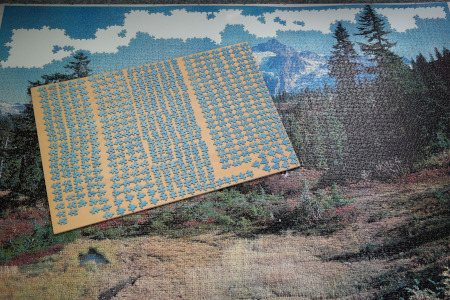
Are you wondering what are the best jigsaw puzzles for speed puzzling competitions? Well, you might notice some immediate signs of good jigsaws to solve in competitions and hard puzzles. We’ve complied a list of pros and cons for you to consider.
When I am out playing at speed puzzling competitions I realize that one of the most important parts of the play is the type of puzzle used. I don’t play competitions with random cut or pieces all of the same color. Instead I look for images that fits best into my skillset and focus on what I love to assemble at speed puzzle competitions. I also take all the speed puzzling tips I’ve been studying when I practice and utilize them for a chance to really get into the moment.
Table of Contents
Speed Puzzling Competitions Vary Based on Jigsaw Puzzles
Jigsaw puzzles have transcended their traditional status as leisurely pastimes to become dynamic arenas for speed puzzling competitions. As enthusiasts across the globe gather to race against the clock to get the best time, the choice of the right jigsaw puzzle plays a pivotal role in determining the success and enjoyment of these fast-paced events.
Let’s delve into the world of jigsaw puzzles, understand why it is important to have some pattern recognition and explore the pros and cons of various types, revealing which puzzles are best suited for the thrilling world of speed puzzling.
1. Traditional Image Puzzles
Pros: Classic image puzzles, featuring landscapes, animals, or famous artworks, are widely available and enjoyed by a broad audience. Their familiarity can make them accessible to participants of all ages and skill levels. These puzzles often have a range of piece shapes, adding an extra layer of complexity for speed puzzlers.
Cons: The familiarity of traditional image puzzles can also pose a challenge for speed puzzling competitions, as finding specific pieces might become too intuitive for some participants. Additionally, the vast range of designs may lead to differences in difficulty levels, impacting the fairness of competitions. Choosing the right design is all about understanding what is available for your game play.
2. Abstract or Geometric Puzzles
Pros: Abstract or geometric puzzles provide a unique challenge for speed puzzlers. With no discernible image, participants must rely solely on the shapes and colors of the pieces, enhancing spatial reasoning and pattern recognition skills. These puzzles often have a more uniform difficulty level, ensuring a fair competition.
Cons: The lack of a clear image may deter some participants who prefer puzzles with recognizable pictures. Additionally, abstract puzzles might not be as visually engaging for those who enjoy the aesthetic appeal of traditional image puzzles.
3. Gradient or Monochromatic Puzzles
Pros: Puzzles with gradients or monochromatic designs offer a sleek and modern twist to speed puzzling competitions. The subtle transitions between shades present a challenge in finding piece matches, requiring participants to rely heavily on the subtle variations in color.
Cons: The absence of distinct features or images might make these puzzles less appealing to some speed puzzlers who appreciate the visual satisfaction of completing a recognizable picture. Additionally, individuals with color blindness may find these puzzles more challenging.
4. Irregular Piece Shapes
Pros: Puzzles with irregular piece shapes, where traditional edge pieces may not form a complete border, add an extra layer of complexity. This style of puzzle rewards participants with a keen eye for unconventional connections, making it well-suited for advanced speed puzzlers.
Cons: Beginners or those new to speed puzzling might find irregular piece shapes daunting, potentially discouraging participation. Additionally, speed puzzling competitions with these puzzles may require a higher level of skill stratification to ensure fair play.
5. Double-Sided Puzzles
Pros: Double-sided puzzles present a unique challenge by requiring participants to consider both sides simultaneously. This adds an extra layer of difficulty, testing the puzzler’s ability to visualize the final image and identify corresponding pieces.
Cons: Double-sided puzzles can be disorienting for some participants, especially those new to speed puzzling. The increased complexity may also lead to longer solving times, potentially impacting the pace of competitions.
6. Custom Photo Puzzles
Pros: Custom photo puzzles, featuring personal images or artworks, add a sentimental touch to speed puzzling. These puzzles are highly engaging and offer a unique experience, allowing participants to connect emotionally with the images they are assembling.
Cons: Custom photo puzzles may introduce a bias if participants are unfamiliar with the images. Additionally, the level of difficulty can vary widely based on the chosen images, potentially impacting the fairness of competitions.
Personal Preferences Matter
The reality is that personal preference is key to finding the right speed puzzling competition that shares your favorite type of puzzle. The best jigsaw puzzles for speed puzzling depend on the preferences and skill levels of the participants. Traditional image puzzles offer familiarity and accessibility, while abstract or geometric puzzles provide a more uniform challenge.
Ultimately, a well-balanced speed puzzling competition may feature a variety of puzzle types to cater to a diverse group of participants. And that’s why you need to research the type of jigsaw puzzles used in play for the speed puzzle competition. Then you need to understand how to quickly open the jigsaw box for best play. This is why you must practice accordingly!
I love that the world of speed puzzling invites enthusiasts to explore the vast and engaging spectrum of jigsaw puzzle possibilities. And I can’t wait to join a puzzle competition to meet you in the near future!
